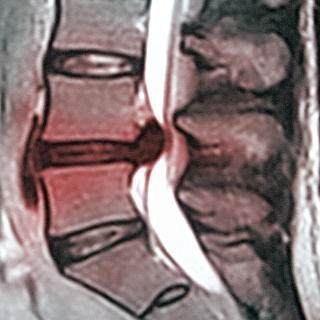Disc degeneration is more common in people with low back pain
Ten pages on PainSci cite Brinjikji 2015: 1. When to Worry About Low Back Pain 2. (Almost) Never Use Ice on Low Back Pain! 3. The Complete Guide to Low Back Pain 4. The Complete Guide to Chronic Tension Headaches 5. The Complete Guide to Neck Pain & Cricks 6. Your Back Is Not Out of Alignment 7. The Double-Edged Sword of Imaging to Diagnose Pain 8. No obvious neck abnormalities in headache patients 9. Pictures of spinal inflammation: a correlation kerfuffle 10. A tale of two papers about structure and back pain

PainSci commentary on Brinjikji 2015: ?This page is one of thousands in the PainScience.com bibliography. It is not a general article: it is focused on a single scientific paper, and it may provide only just enough context for the summary to make sense. Links to other papers and more general information are provided wherever possible.
This is one half of a tale of two papers: a pair published by the same researchers, who looked at a whole lot of MRI pictures of spines. The other paper (Brinjikji) presents evidence that signs of spinal degeneration are present in very high percentages of healthy people with no problem at all.
Good to know.
But this paper presents evidence that degenerative features visible on MRI are nevertheless “more prevalent in adults 50 years of age or younger with back pain compared with asymptomatic individuals.”
Also good to know.
Delicious cognitive dissonance? 😜 The take-home message is actually just a nice, reasonable compromise between two well-known viewpoints: degenerative changes matter less than many patients and professionals still assume, and are not an adequate foundation for many popular treatments, but they do still matter. Duh.
original abstract †Abstracts here may not perfectly match originals, for a variety of technical and practical reasons. Some abstacts are truncated for my purposes here, if they are particularly long-winded and unhelpful. I occasionally add clarifying notes. And I make some minor corrections.
BACKGROUND AND PURPOSE: Imaging features of spine degeneration are common in symptomatic and asymptomatic individuals. We compared the prevalence of MR imaging features of lumbar spine degeneration in adults 50 years of age and younger with and without self-reported low back pain.
MATERIALS AND METHODS: We performed a meta-analysis of studies reporting the prevalence of degenerative lumbar spine MR imaging findings in asymptomatic and symptomatic adults 50 years of age or younger. Symptomatic individuals had axial low back pain with or without radicular symptoms. Two reviewers evaluated each article for the following
OUTCOMES: disc bulge, disc degeneration, disc extrusion, disc protrusion, annular fissures, Modic 1 changes, any Modic changes, central canal stenosis, spondylolisthesis, and spondylolysis. The meta-analysis was performed by using a random-effects model.
RESULTS: An initial search yielded 280 unique studies. Fourteen (5.0%) met the inclusion criteria (3097 individuals; 1193, 38.6%, asymptomatic; 1904, 61.4%, symptomatic). Imaging findings with a higher prevalence in symptomatic individuals 50 years of age or younger included disc bulge (OR, 7.54; 95% CI, 1.28-44.56; P = .03), spondylolysis (OR, 5.06; 95% CI, 1.65-15.53; P < .01), disc extrusion (OR, 4.38; 95% CI, 1.98-9.68; P < .01), Modic 1 changes (OR, 4.01; 95% CI, 1.10-14.55; P = .04), disc protrusion (OR, 2.65; 95% CI, 1.52-4.62; P < .01), and disc degeneration (OR, 2.24; 95% CI, 1.21-4.15, P = .01). Imaging findings not associated with low back pain included any Modic change (OR, 1.62; 95% CI, 0.48-5.41, P = .43), central canal stenosis (OR, 20.58; 95% CI, 0.05-798.77; P = .32), high-intensity zone (OR = 2.10; 95% CI, 0.73-6.02; P = .17), annular fissures (OR = 1.79; 95% CI, 0.97-3.31; P = .06), and spondylolisthesis (OR = 1.59; 95% CI, 0.78-3.24; P = .20).
CONCLUSIONS: Meta-analysis demonstrates that MR imaging evidence of disc bulge, degeneration, extrusion, protrusion, Modic 1 changes, and spondylolysis are more prevalent in adults 50 years of age or younger with back pain compared with asymptomatic individuals.
related content
- “The value of magnetic resonance imaging of the lumbar spine to predict low-back pain in asymptomatic subjects,” Borenstein et al, Journal of Bone & Joint Surgery (American), 2001.
- “Three-year incidence of low back pain in an initially asymptomatic cohort: clinical and imaging risk factors,” Jarvik et al, Spine (Phila Pa 1976), 2005.
- “Prospective controlled study of the development of lower back pain in previously asymptomatic subjects undergoing experimental discography,” Carragee et al, Spine (Phila Pa 1976), 2004.
- “The Twin Spine Study: contributions to a changing view of disc degeneration,” Battié et al, Spine J, 2009.
- “Systematic Literature Review of Imaging Features of Spinal Degeneration in Asymptomatic Populations,” Brinjikji et al, AJNR Am J Neuroradiol, 2015.
This page is part of the PainScience BIBLIOGRAPHY, which contains plain language summaries of thousands of scientific papers & others sources. It’s like a highly specialized blog. A few highlights:
- Common interventional procedures for chronic non-cancer spine pain: a systematic review and network meta-analysis of randomised trials. Wang 2025 BMJ.
- Gabapentinoids and Risk of Hip Fracture. Leung 2024 JAMA Netw Open.
- Classical Conditioning Fails to Elicit Allodynia in an Experimental Study with Healthy Humans. Madden 2017 Pain Med.
- Topical glyceryl trinitrate (GTN) and eccentric exercises in the treatment of mid-portion achilles tendinopathy (the NEAT trial): a randomised double-blind placebo-controlled trial. Kirwan 2024 Br J Sports Med.
- Placebo analgesia in physical and psychological interventions: Systematic review and meta-analysis of three-armed trials. Hohenschurz-Schmidt 2024 Eur J Pain.